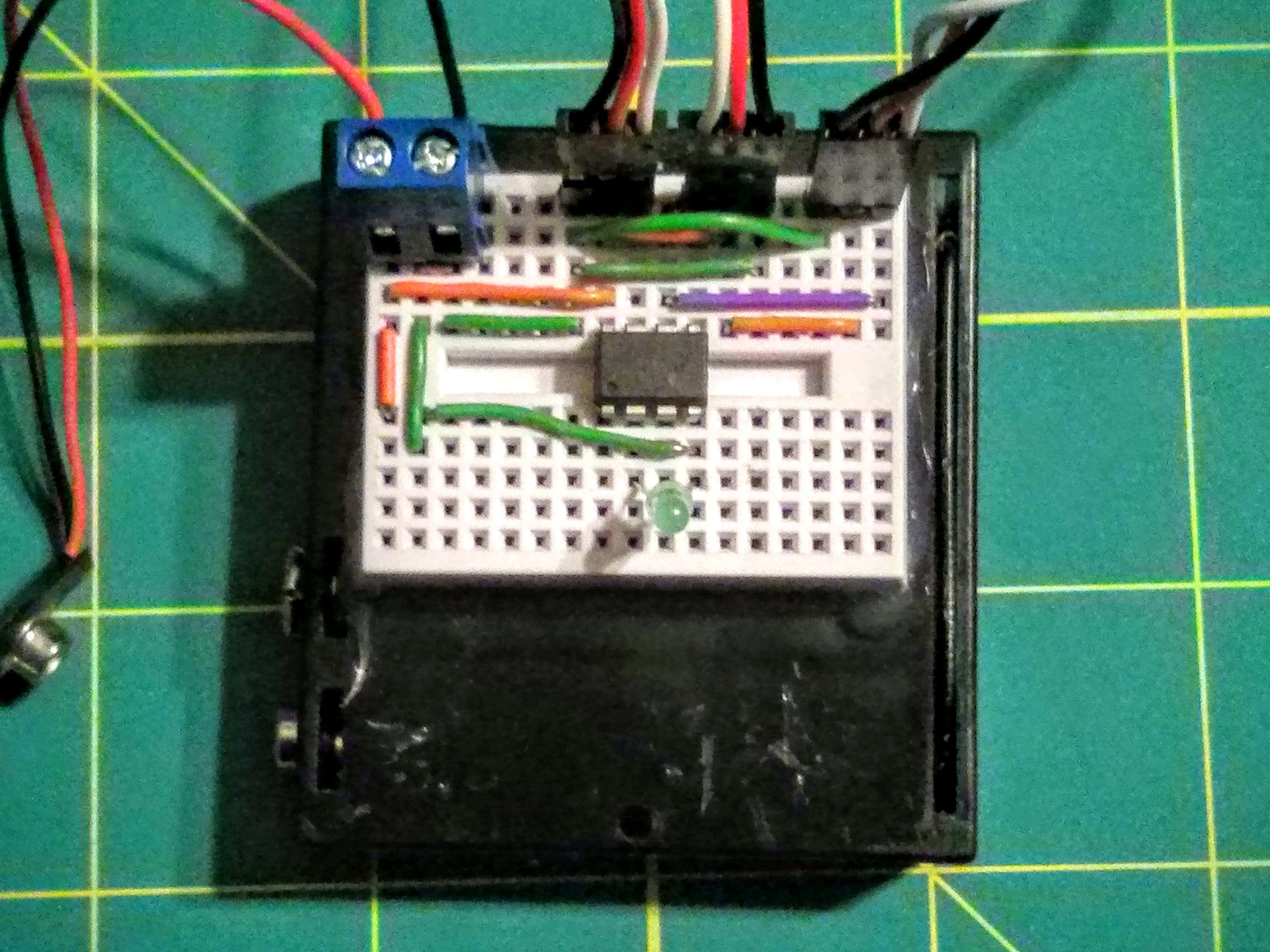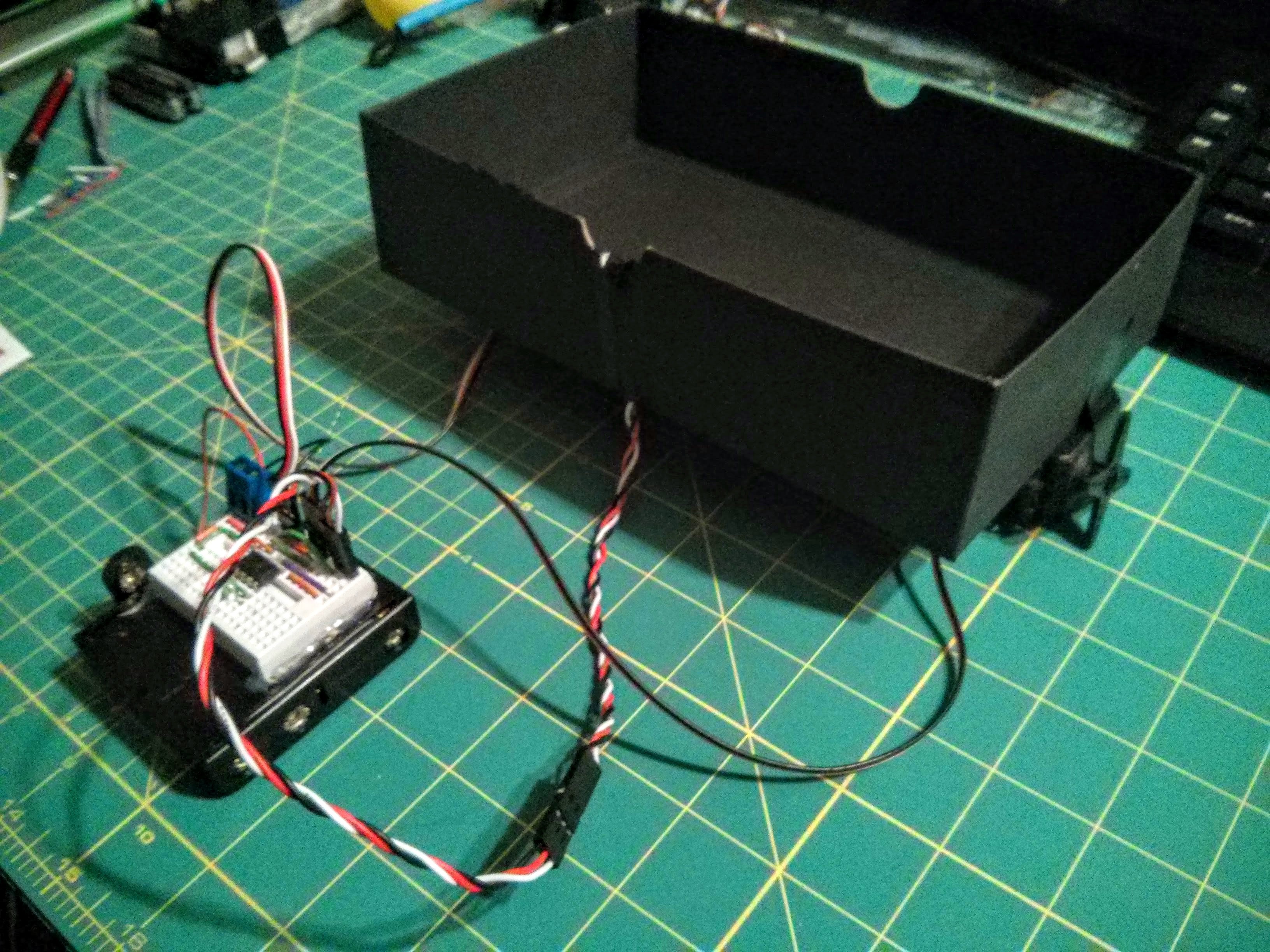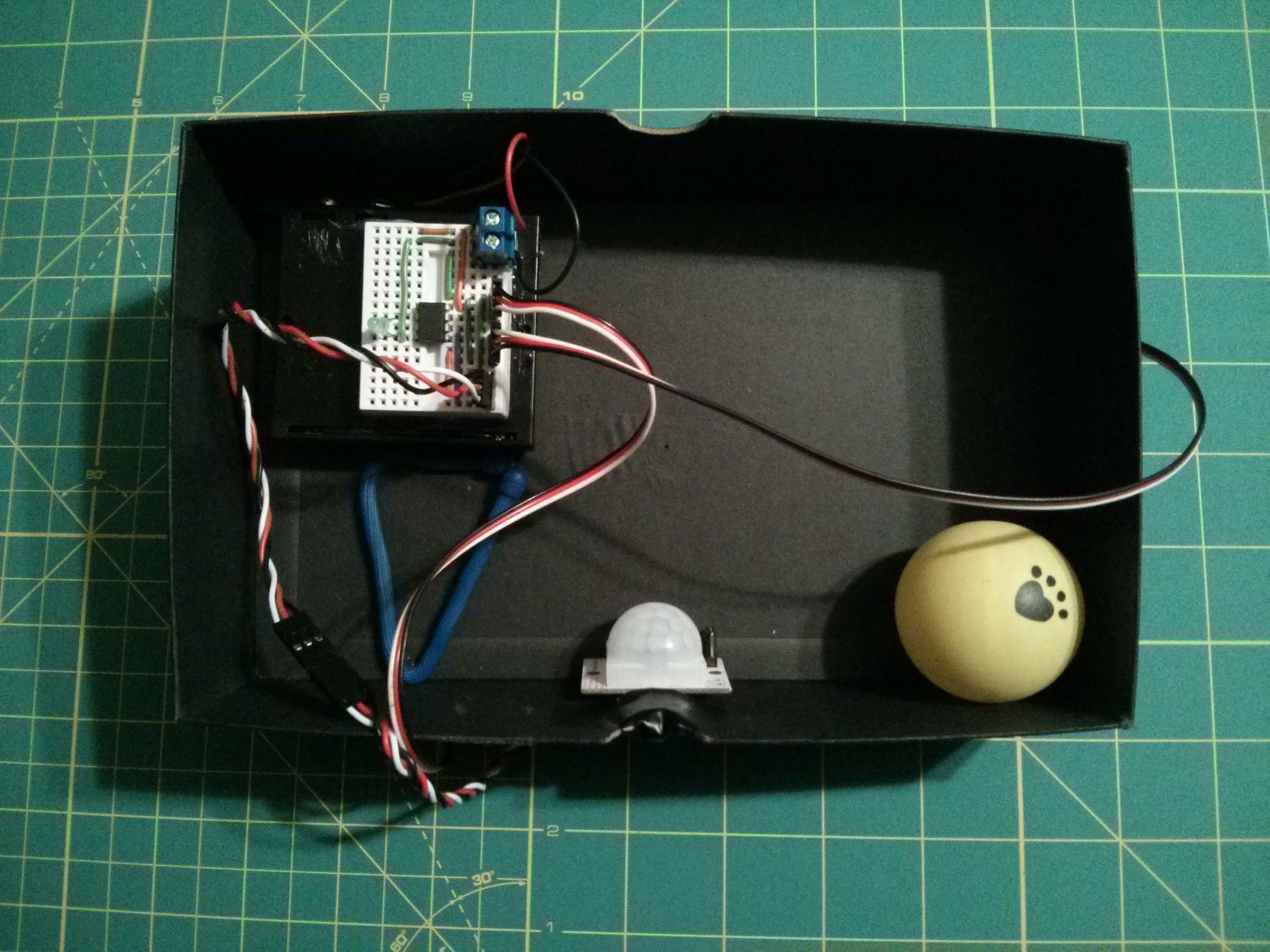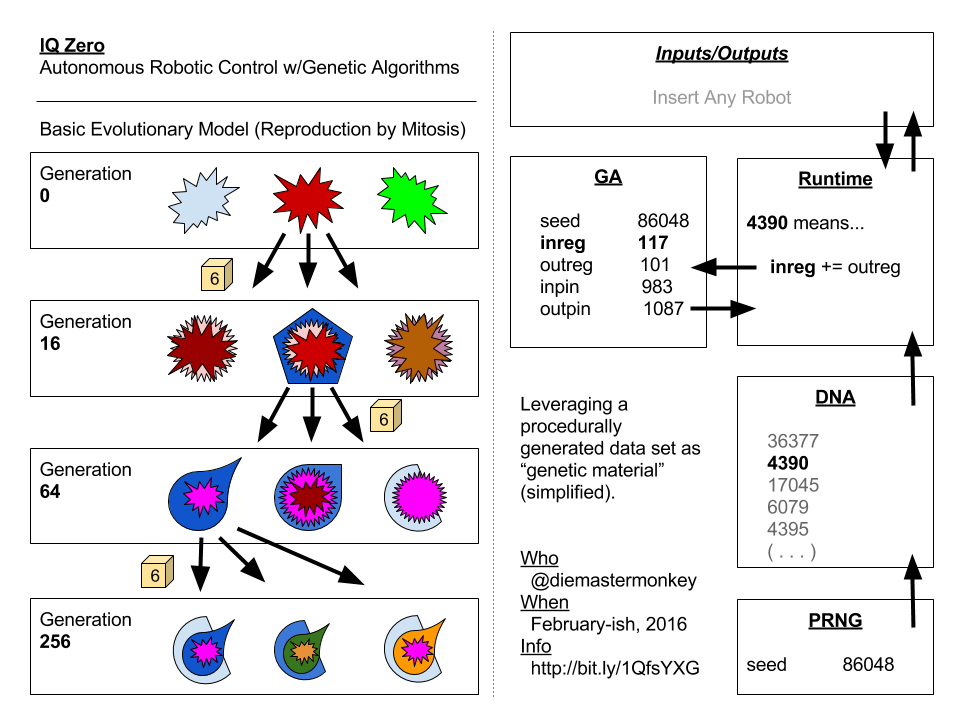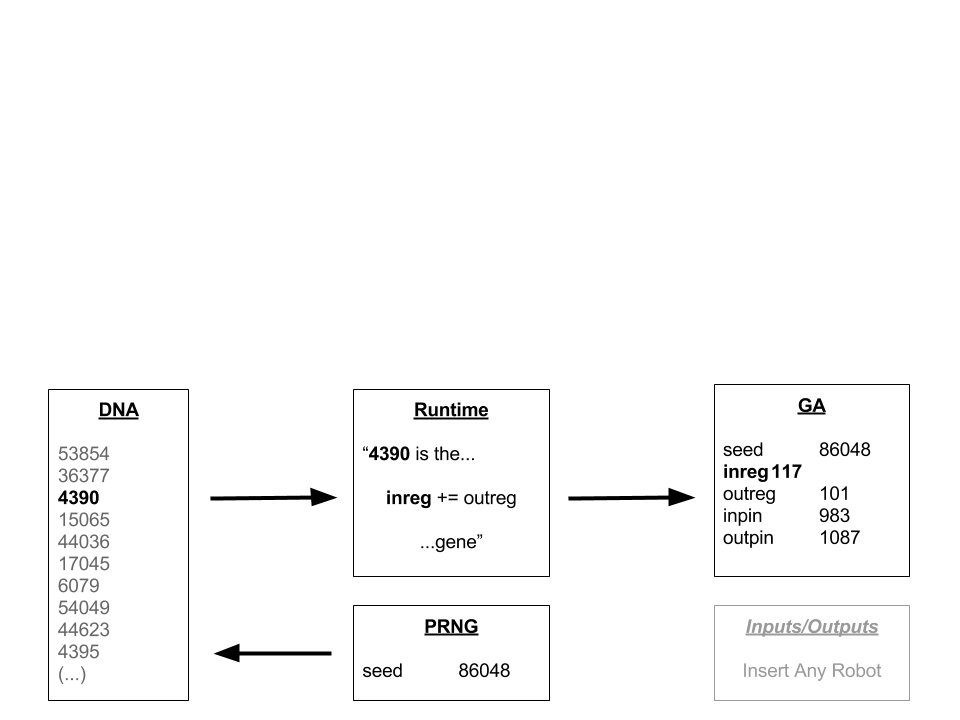-
OMG Finally an Update!
12/20/2016 at 08:20 • 0 commentsDuring a test run of some new code, I give a long update on this thing and it is - I think - an interesting story. For some reason it's on my other YouTube channel. Sorry about the reverb.
Latest: I should be posting new, civilized code soon that - as always - won't care what kind of peripherals it has. And Happy Holidays Everyone!
-
IQ Zero Box 8 Run w/Timelapse
03/16/2016 at 00:55 • 0 commentsThis run with the latest (ATTiny) version is a good illustration of the GA technique as it's applied in this project. Again the bot is scored on how well it stimulates the Passive Infrared Sensor (PIR) - usually by jostling the ball as much as possible. And as before, the values for its operations are pulled directly from the seed-controlled PRNG.
More discussion after the vid.
The clip fast-forwards through 35+ generations, and in that time the bot goes from using all of its servos all of the time to what appears to be a more efficient locomotive pattern that often bounces the ball violently.
A few factors play into what behavior scores best:
- PIR: Any motion sensed by the PIR will score 10 points per instruction cycle. A single event may trigger for up to 4 seconds.
- Servo Cost: Each time output is sent to servos, a 2 point penalty is given.
- Time: Each GA has only 4 seconds, so inaction is the most costly of all.
Importantly, the GA does not approach some sort of "perfection" and stay there: It continues to mutate, constantly. This - again - is what excites me so much about these techniques: These kinds of robots could adjust constantly to changing demands, or opportunities.
There is considerable work to be done still - I'm currently focusing on the following:
- More stable convergence - Do a better job of identifying and keeping the positive aspects of successful GAs
- More GA self-influence - They currently have surprisingly little control over their own code morphology. I'm expanding that.
- More fitness tests - I score motion now because I can't score distance, altitude or light. The next item will help add more test sensors!
- PI Zero Transition - I'm ironing-out a plan to put the Adafruit Contest's PI Zero in charge of a herd of "traditional" IQ Zeros. Clever angle, no?
Stay tuuuuuuuunnnnnned!
-
Bot in "Box Arena"
03/10/2016 at 22:09 • 0 commentsSome better pics of the "Box Arena", where Zero is tasked with figuring-out how to stimulate the Passive Infrared Sensor by operating servos attached to the bottom of the box. See video of this in operation in an earlier post.
![]()
![]()
![]()
-
Bits Bots Beats - IQZero: Trash, Chaos and Computation
03/04/2016 at 03:38 • 0 commentsThe project figured strongly in the latest episode of Twitch geek-and-beat-sesh "Bits Bots Beats" (Wednesdays 6pm GMT-8).
Topics included:
- Borrowing computer time
- Is random always trash?
- Is trash always useless?
- Are useful things always designed?
- Beats by RVNEZ
Incidentally, a big update is in the works with a completely different model - stay tuned. Thanks for checking it out so far!
-
IQ Zero "Arm" Test
03/01/2016 at 02:31 • 0 commentsThis Robot is "Armed"
Yes, I still have to finish explaining the other half of The Big Diagram, but I wanted to share this quick dispatch from the lab. Forgive me also for typos and such, because (hey admins!) it is extremely difficult to edit articles here. Moving on...
In this test, Zero is placed in charge of a crude two-servo armature and - again - scored on how often (and how efficiently) it stimulates the Passive Infrared Motion Detector. The "PIR" is partly obscured, forcing the Genetic Algorithm to discover a small range of effective motion.
Here is an example of its performance within the first minute or so:
It doesn't really succeed in triggering the sensor much, and spends much of its time outside the PIR's field of vision.
A few dozen generations later, it's considerably more effective and seems to be generating "GAs" that at least focus their motion to the useful area.
It's hard to be sure, but it might even be responding to sensor event by "bouncing" back to a clockwise extreme, then slowly creeping back toward the sensor.
This is possible because some of the "commands" which can result from interpretation of its pseudo-random DNA can read like this:
- Read value of from InPin to InReg
- Skip next instruction if InReg > OutReg
- Write value of OutReg to OutPin
Consider the following scenario, in effect at the time these instructions were executed:
- InPin is attached to the PIR
- OutReg is zero
- OutPin is attached to the arm servo
If this were the case, a zero would be sent to the servo if the value read from the PIR sensor were higher than zero. Zero degrees, being outside the range of the servo, would push the arm all the way clockwise.
Conversely, if the PIR returned nothing (zero), InReg would not be greater than OutReg, and Step 3 would be skipped. No servo action would result.
Actually this background is going to be useful in...
Next Up: Chaos from Code Part II - Time, PRNGs and Fake Languages
-
Turning Chaos Into Code
02/27/2016 at 21:14 • 0 commentsFlattening Evolution
Yay, finally a diagram! Opening it in a new window might make the following discussion easier. I'm going to start with the left-side, a simplified workflow of Zero's version of evolution.
![]()
Firstly, let me disclaim that the Evolutionary model used in this project is simplistic in the extreme. That's mostly by design: It's on an ATTiny85, and that certainly demands we make the most of limited resources. More importantly, this is not a simulation of biological Evolution for research purposes but rather an emulation of only those mechanisms of Evolution which I deem conducive to emergent, productive behavior in a hardware control program (i.e. robot).In the diagram, think of the shapes as representing different forms Zero's program might take: Say, a rounded surface represents a sequence of code that increments one of its registers, and the blue-ness of a shape represents its likelyhood of that register being used as an analog output. Other colors and shapes represent other facets - and we'll get to where those come from in a bit.
Imagine also that the number of shapes represent the complexity of the program. For instance, the pseudocode for one of the Generation 0 might be:
Read From InPin to InReg
Increment OutReg
RepeatThat's a very simple (and probably not very productive) program. If we checked its sibling we'd find something slightly different (we'll get to mutation, hold on). Something like:
Read From OutPin to InReg
Increment OutReg
RepeatThere's only one tiny difference (in bold), but there can also be several - or none. But siblings of one generation will tend to be very similar because they're all derived from the same (parent) DNA.
Nature's a Playa
I say siblings tend to be similar because mutations can have consequences to an organism that are benign, subtle or profound - depending on where the mutation occurs in the DNA and how that gene is expressed. Sheesh, is this helping explain anything? Okay, let's take another hypothetical Generaion 0 sibling:
Read From OutPin to InReg
Increment OutReg
Increment OutRegOkay, this one too is "slightly different" - again only one line was mutated. It's harmless that "OutReg" is incremented again, as the program does nothing with it anyways. However, the replacement of "Repeat" (with anything else) will prove disastrous and this sibling will have the shortest robotic lifetime ever - a single execution.
So while the diagram "fast forwards" through generations, but that doesn't mean only "time" can introduce big changes to an genetic line. Major changes to any part can happen suddenly through several mechanisms, just of one of which is illustrated above.
In our particular implementation, the "seed" value provided to the PRNG is a crucial part of the DNA, but it is also subject to mutation: Since the PRNG generates all instructions for its program, the slightest change to it drastically alters the resulting offspring.
If it seems to you that there is a high chance that mutations will result in unproductive behavior (i.e. "dead babies"), then you are paying attention and get a cookie! You are correct - and dying is not good performance. So those genes are not selected to go on to the next generation.
That sounds a lot like two steps forward, one step back. Maybe two steps back, sometimes!
It is - but Nature is also waiter. Not like "try the wine" but like - well you get it.
And while time is the limiting factor in this process, time in Evolution is not time in the way watches measure it.
{Sheesh, that's a lot for ya'all to read at once - I think I'd better pick this up in the next post, where I'll explain wth I mean time is not time that's crazy talk. Thanks for tuning in!}
-
IQ Zero in "Box3" Arena
02/24/2016 at 19:51 • 0 commentsBot Versus Ball in Box of Doom
Okay so there's no doom, but that's a catchy title, no? Placed in charge of bouncing a box with a ball in it to stimulate a motion detector, "Zero" quickly discovers a quite optimal technique requiring minimal motion, and doing quite a good job of letting gravity do much of its work!
This is precisely the same code as in any other "Zero" - it has no idea what it's doing, only that when it happens to use this random seed with these combinations of values in the body it currently inhabits, it is often fed. It likes being fed, and it likes passing on its genes to future generations.
"And that's all Skynet really was, son."
Hmm, did I say there was no doom in this post?
Yes I know, where's the diagram, on the way boss! :)
-
Zero Invents "Wheel Rowing"
02/24/2016 at 19:04 • 0 commentsYeah I said the next post would be about the translation from PRNG-generated integer streams into actionable instructions for a Genetic Algorithm - but first, a video! Strapped-onto a toy car and left for a few hours, "Zero" seems to have invented a clever - if not particularly exciting - method of "rowing" one of the car's wheels, nudging it a few inches each time.
Come to think of it, it's solution is pretty efficient, from an energy expenditure perspective.
Understand that if we ran it again (and I have), it will come up with different solutions. And if that wheel broke it would figure something else out. That's why I'm so hot for this stuff - imagine, machines to which we can finally say "you're the expensive computer - you figure it out!" :)
Right, so how does a glob of instructionspace DNA become a new way to push a wheel? Yes, I promised, okay next post but - with a diagram so - worth the wait. Here's a sneak peek:
![]()
-
Robot Cars and Robot Bikers
02/24/2016 at 07:36 • 1 commentHilariously, YouTube "related" one of my uploads about "IQ Zero" to this talk from Ben Goertzel (whom I've met, he's a cool cat) about Artificial (rather, Algorithmic) General Intelligence. His example about a car-driving program in a motorcycle perfectly illustrates what this project is about.
(Omg you can just paste vids here?)
So this is why the "components" list is empty, except for an Arduino-C compatible processor: The entire point of this project is to be able to plug IQ Zero into whatever - and have it just figure out how to make itself useful.
PS I'm totally gonna' be posting video updates in these log things then, cause you don't get a description on links.
-
Hello Hackaday
02/24/2016 at 07:03 • 0 commentsInitial Post on IQ Zero Project
I don't usually use project sites like this - guess I'm Old School already. But I wanted to enter the Adafruit PI Zero Contest so here I am!
Actually "Zero" is one of many Genetic Algorithm projects I've got going - the continuation of my 10-plus-year experimentation in Evolution Computing. I wasn't originally planning on using it for the contest - my larger project "Internet Toybox" seemed the obvious choice.
But I've been b struggling with some of the limitations of the (self-imposed) ATTiny85 platform I've been using for "IQ Zero". GA's don't technically require much processing power - and shouldn't if done right, in my opinion.
But the limited runtime memory (which did lead to a brilliant innovation leveraging Procedural Generation) and slow random number generation at 16mhz has caused me to seriously consider adding an internal simulation phase to the system.
Some quick background: Genetic Algorithms are traditionally explored, for the purposes of physical "organisms", in simulation. "Breve Creature Simulator" for example, with which I started, uses a physics-simulated 3D environment.
But not every single moment of GA evolution is rendered - that would slow the simulation to "real time"! Instead, only the math is performed for most generations, and then - once in a while - a generation is rendered on screen.
IQ Zero isn't a simulated organism - it's a real-world robot! To test 300 generations takes - well, 300 generations. To make this feasible, I've limited myself to goals ("fitness tests") which could be achieved by a fairly simple means - allowing me to give each individual "Zero" a fairly short life - 20 to 30 seconds, for instance.
I can already see I'll want more complex behaviors: Longer, slower, more delicate motions and more awareness of the state of the environment. One way is to wait overnight.
But another is a 1 GHZ processor on a board light enough to be carried by a 5-volt robot with no knowledge of its own arms and legs.
So wish me luck on the PI Zero contest, and stay tuned for all the code, diagrams, docs and vids you can handle. Thanks for tuning in!
IQ Zero: Evolving Unprogrammed Robots
Clueless, broken robots thrive on Genetic Algorithms and Procedural Generation
 Die, Master Monkey!
Die, Master Monkey!